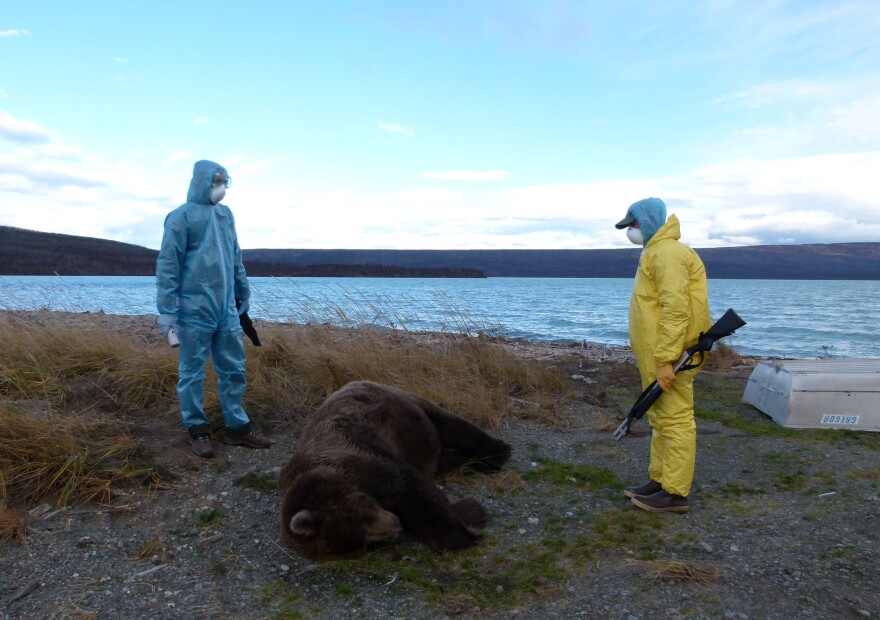Thousands watched via bear cams as two bruins quietly laid down and died. In a rare and mysterious case of non-traumatic bear death, those viewers have taken on the roles of both witness and investigator.
Last month at Katmai National Park, the final hours of two brown bears played out in front of an online audience of thousands. The two animals laid down and died within days of each other.
As Hannah Colton reports, bear cam viewers are acting as both eye-witnesses and detectives in this curious case…
Audio transcript:
Wednesday, October 21st started as a normal fall day at Brooks Camp. Bears were fishing, preparing to den up. A sow and two cubs wandered in front of a camera close to Naknek Lake.
Then something strange happened, something that might have gone unnoticed if it weren’t for the thousands of bear cam fans who are always watching...
"We could see the cub stumbling, and its legs not really working, and then it kind of collapsed."
That’s Diana from Maryland, a 3-year veteran bear cam watcher who goes by the online name LovetheCams. She was paying close attention when spring cub started acting strange. That evening, she says, the comment board was swirling with confusion.
"Like, what’s happening to this cub, what’s going on? The first day the cub moved a little, but it didn’t ever return to its feet."

Diana says she took careful notes, counting each respiration. The cub took its last breath on Friday, October 23rd.
Troy Hamon is the Chief of Resource Management for Katmai National Park & Preserve. The staff decided to have the cub autopsied, so a few of his colleagues boated out and collected the 60-pound carcass.
"Which is surprisingly heavy... and we shipped it to the National Wildlife Health Center in Madison, Wisconsin."

This is uncharted territory for Katmai rangers. Hamon says they’ve never had a bear necropsy done, because they’ve rarely - if ever - witnessed a bear die of an unknown cause.
"We see bears being killed by other bears, we also see occasionally adult bears killing each other… But our understanding of the non-traumatic deaths is fairly uncommon."
From a biologists’ point of view, this was a unique opportunity to learn about bear mortality.
And as Hamon describes, they were about to get twice the opportunity.
"The situation is, when our staff pulled up to collect the cub, there were some webcam viewers that clipped images from the video of our people arriving."
This compulsive documentation paid off when a few hours later, viewers looked at that same location, and saw a big dark bear-shaped blob where there hadn’t been a dark blob before.
By comparing the before and after photos, they could pinpoint just when the dark shape had parked itself out on a sand spit. Hamon says this caught people’s attention –
"- Not because the bear laid down, but because it was still there the next day... and the next day. We have bears that lay down and sleep for 6 hours, or even sleep for a day, but when a bear lays down for two days, it’s dead."
Rough weather kept the wildlife staff from returning to the second body for a few days, but Hamon says he and other soon rangers determined that the deceased was an adult male. They knew because they’d watched another mother with cubs who walked by, took one look at the bear on the ground, and bolted. Hamon says this is a telling reminder of bear social dynamics.
"The bear hierarchy system is very funny – a very important bear remains very important even after death."

Meanwhile on the comment board, people now had two bears to grieve – and two mysterious deaths to investigate. As viewers hashed over details and re-constructed a timeline of events, Diana says they were in full-on speculation mode:
"I’ve read everything from, you know, foul play – has someone poisoned them? Could it have been something chemical that leaked from a boat or left by a park visitor? Is it the plants, is it the mushrooms? Could it be disease? Could it be neurological?"
Ranger Michael Saxton is one of the bear technicians who collected the cub’s body. He says so far only a few things have been ruled out by the lab in Wisconsin.
"Rabies is negative, toxoplasmosis is negative as well - that’s just a contagious disease they check for."
Samples from the adult male were sent to a state veterinarian, but the tissue was too decayed to do most diagnostic tests.

Diana says many bear cam watchers were deeply affected by the deaths, especially the spring cub’s. And there’s a tension in the comments, between those who are mourning the bears as you might a pet, and those who see themselves more as citizen scientists.
Diana is hungry for more information. But her mind keeps returning to certain moments, like when the sow and her healthy cub returned to where the cub lay dead.
"She would sniff near the cub and approach the cub near its muzzle, and seemed to be checking for things. And as a mom, I understand that - checking for things, looking for clues as to what’s wrong. And I would like to have some answers to that."
Those answer may or may not come with the results of the necropsy.
Contact the author at hannah@kdlg.org.





